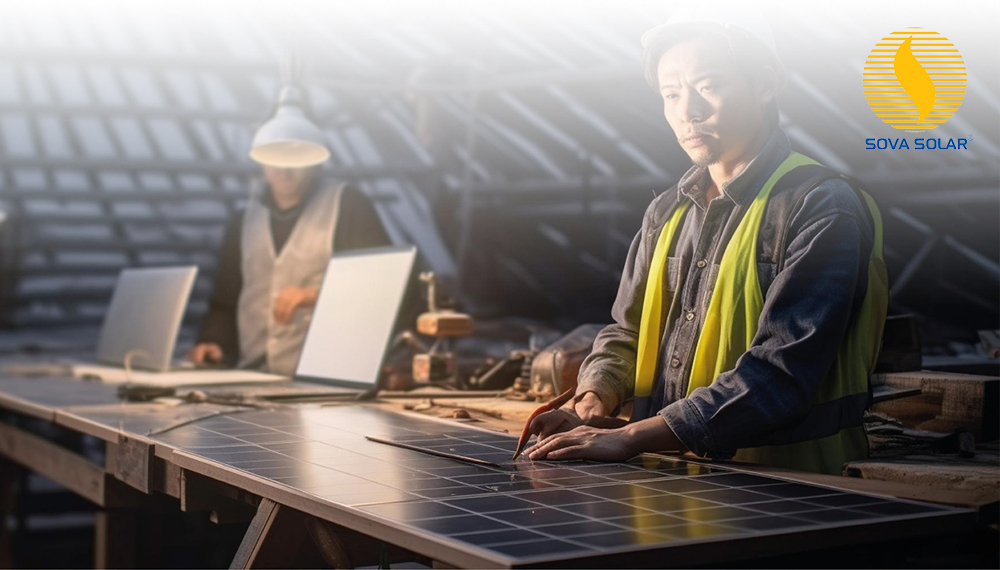
- sovasolar_admin
- Jul 29, 2024
- Agriculture, Industry, Production
- 0 Comments
Integrating Solar Energy into Manufacturing Processes: Benefits and Challenges
The manufacturing industry is a significant consumer of energy, and as global concerns about climate change and sustainability grow, there is increasing pressure on manufacturers to adopt greener practices. Integrating solar energy into manufacturing processes presents a promising solution to reduce environmental impact and operational costs. This blog explores the benefits and challenges of incorporating solar power into manufacturing, with a focus on the role of solar system manufacturers in Delhi and Kolkata in facilitating this transition.
Benefits of Integrating Solar Energy
1. Cost Savings
One of the most compelling benefits of integrating solar energy into manufacturing processes is the potential for significant cost savings. Solar energy can drastically reduce electricity bills, particularly for energy-intensive operations. Over time, the savings on energy costs can offset the initial investment in solar technology.
2. Energy Security and Independence
Solar energy provides manufacturers with greater energy security and independence. By generating their own power, manufacturers can reduce their reliance on the grid and protect themselves against volatile energy prices and supply disruptions. This is particularly beneficial in regions with unreliable electricity supply.
3. Environmental Impact
Solar energy is a clean, renewable resource that significantly reduces carbon emissions compared to fossil fuels. By integrating solar power, manufacturers can lower their carbon footprint and contribute to environmental sustainability. This is increasingly important as consumers and stakeholders demand greener business practices.
4. Enhanced Brand Image and Market Position
Adopting solar energy can enhance a manufacturer’s brand image and market position. Companies that demonstrate a commitment to sustainability are more likely to attract environmentally conscious consumers, partners, and investors. This can also provide a competitive edge in an increasingly eco-aware market.
5. Government Incentives and Support
Many governments offer incentives and subsidies to promote the adoption of renewable energy. These can include tax credits, grants, and low-interest loans, which can make the transition to solar energy more affordable. Manufacturers can take advantage of these incentives to reduce the financial burden of solar installation.
Challenges of Integrating Solar Energy
1. High Initial Investment
The upfront cost of purchasing and installing solar panels and related infrastructure can be high. This is a significant barrier for many manufacturers, especially small and medium-sized enterprises (SMEs). However, the long-term savings on energy costs and available government incentives can help mitigate this challenge.
2. Space Requirements
Solar panels require considerable space for installation, which can be a challenge for manufacturers with limited roof or ground space. Innovative solutions, such as solar carports or integrating panels into building facades, can help address space constraints.
3. Intermittent Energy Supply
Solar energy is dependent on sunlight, which means it is not always available, especially during cloudy days or at night. Manufacturers need to implement energy storage solutions, such as batteries, or maintain a backup power source to ensure a consistent energy supply.
4. Technical and Maintenance Challenges
Integrating solar energy into manufacturing processes requires technical expertise in system design, installation, and maintenance. Manufacturers need to partner with experienced solar companies to ensure the system operates efficiently and reliably. Regular maintenance is also crucial to maintain optimal performance.
5. Regulatory and Compliance Issues
– Navigating the regulatory landscape for solar energy installation can be complex. Manufacturers must ensure compliance with local regulations and obtain necessary permits. Working with knowledgeable solar system manufacturers and installers can help simplify this process.
Role of Solar System Manufacturers in Delhi and Kolkata
In Delhi:
Solar System Manufacturers in Delhi: These manufacturers provide end-to-end solutions, from designing and supplying high-quality solar panels to installation and maintenance services. Their expertise ensures that manufacturing facilities can effectively integrate solar power into their operations.
Solar Panel Manufacturers in Delhi: Known for their innovation and quality, these manufacturers offer a range of solar panels that cater to different energy needs and budgets. Their products come with warranties and after-sales support, ensuring long-term reliability.
In Kolkata:
Solar System Manufacturers in Kolkata: These manufacturers are dedicated to promoting solar energy adoption in the region. They offer customised solutions tailored to the specific requirements of manufacturing facilities, ensuring efficient energy generation and utilisation.
Best Solar Company in West Bengal: Recognized for their reliability and expertise, these companies provide comprehensive services, including site assessment, system design, installation, and ongoing maintenance. They help manufacturers navigate the regulatory landscape and secure government incentives.
Solar Panel Company in Kolkata: These companies provide high-quality solar panels and related equipment, ensuring optimal performance and durability. Their local presence ensures quick and efficient service and support.
Solar Power Companies in Kolkata: These companies specialise in integrating solar energy into various sectors, including manufacturing. They offer a range of services, from initial consultation and system design to installation and monitoring, ensuring a seamless transition to solar power.
Steps to Integrate Solar Energy into Manufacturing
1. Energy Audit and Feasibility Study
Conduct a thorough energy audit to assess current energy consumption and identify potential savings. A feasibility study will help determine the size and type of solar power system required, considering factors like available space, sunlight exposure, and energy needs.
2. System Design and Planning
Work with a reputable solar system manufacturer to design a solar power system tailored to the manufacturing facility’s requirements. This includes selecting the appropriate solar panels, inverters, and energy storage solutions.
3. Securing Financing and Incentives
Explore financing options and government incentives to reduce the financial burden of the solar installation. Many banks and financial institutions offer loans specifically for renewable energy projects.
4. Installation and Commissioning
Ensure the installation is carried out by certified professionals to guarantee safety and efficiency. The process involves mounting the solar panels, setting up the inverter and other components, and connecting the system to the facility’s electrical infrastructure.
5. Monitoring and Maintenance
Implement a monitoring system to track the performance of the solar power system. Regular maintenance, such as cleaning the panels and checking the connections, is essential to ensure optimal performance and longevity.
Conclusion
Integrating solar energy into manufacturing processes offers numerous benefits, from cost savings and energy security to environmental sustainability and enhanced brand image. However, the transition to solar power also presents challenges, including high initial investment, space requirements, and technical complexities. By partnering with experienced solar system manufacturers in Delhi and Kolkata, manufacturers can navigate these challenges and successfully implement solar energy solutions.
The role of local solar companies is crucial in this process. Their expertise, quality products, and comprehensive services ensure that manufacturers can achieve efficient and reliable solar energy integration. As more manufacturing facilities adopt solar power, they contribute to a sustainable future while reaping the economic and environmental benefits of renewable energy.






